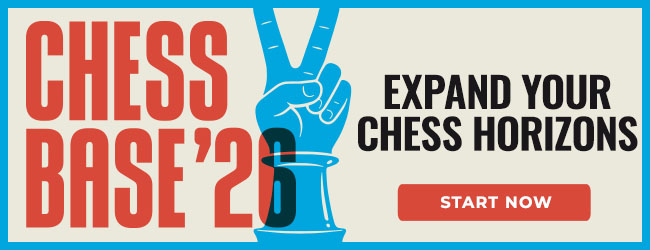Chess Explorations (57)
By Edward Winter

The diagrammed position on the cover of W.E. Napier’s book comes from
a famous miniature won by Hermann Helms, and Napier wrote: ‘Besides brilliancy,
there is a debonair flow from the first move.’ Giving the score on pages
192-193 of The Golden Treasury of Chess (Philadelphia, 1943) Francis
J. Wellmuth observed: ‘A most extraordinary game in that the final moves
were wholly unexpected.’
1 d4 f5 2 Nf3 Nf6 3 c4 e6 4 Nc3 b6 5 e3 Bb7 6 Bd3 Bd6 7 a3 a5 8 O-O O-O 9 Qc2
Nc6 10 e4 fxe4 11 Nxe4 Nxe4 12 Bxe4
12...Nxd4 13 Bxh7+ Kh8 14 Nxd4 Qh4 15 g3 Qxd4 16 Bd3 Rf3 17 Be3 Qe5 18 Rae1
Raf8 19 Bxb6 Qh5 20 Be3 Qh3 21 Be4
21...R8f5 22 Bxf5
22...Qg2+ 23 Kxg2 Rxg3 mate.
There are many discrepancies in the details surrounding the game. Pages 213-214
of the (truly dreadful) book Treasure
Chess by B. Pandolfini (New York, 2007) stated that the opponent of
‘Herman Helms’ (Hermann is the correct spelling) was ‘Samuel
Smyth’. Some sources give the surname as ‘Smith’. See, for
instance, pages 183-184 of the Schachjahrbuch für 1915/16 by L. Bachmann
(Ansbach, 1917), which had ‘J. Ferguson Smith’. Similarly, when
the game was published on page 138 of Schnell Matt! by C. Hüther and
L. Bachmann (Leipzig, 1924) White was named as ‘J.F. Smith’. On
the other hand, ‘J.F. Smythe’ was the version offered when the game
was included on page 185 of the July-August 1919 issue of the American Chess
Bulletin (editor: H. Helms). However, that was an item reproduced from the
New York Evening Post, with the moves merely incorporated within an annotation
to another game.
An early appearance of the Helms miniature in a book was on pages 97-98
of Chess by David
A. Mitchell (Philadelphia, 1917). He stated that White was J.F. Smyth, and
a specific date for the game was given: 23 May 1915. Working backwards, we have
found the score (probably its first publication) on page 3 of the Brooklyn
Daily Eagle, 10 June 1915. Helms’ chess column in that newspaper identified
White as J. Ferguson Smyth and stated that the miniature was a practice game
played at the Manhattan Chess Club on 28 May 1915:
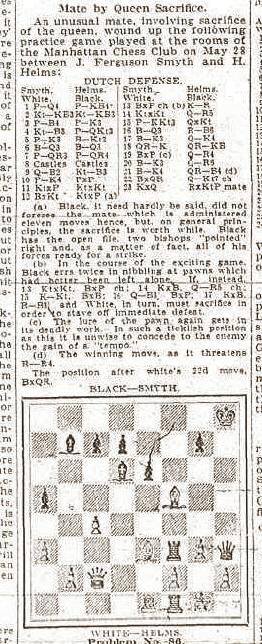
Nearly three decades later the game re-appeared in the American Chess Bulletin.
A.E. Santasiere
annotated Smyth v Helms on page 12 of the January-February 1943 issue, and his
penultimate note read:
‘I wish our friend, the perpetrator of this deed, would relate to us
the immediate reactions to this move [22...Qg2+] i.e. how did his opponent
take it, the audience, etc., etc.’
Immediately afterwards, Helms elucidated:
‘The encounter was between James F. Smyth and H. Helms at the Manhattan
Chess Club, then in the Carnegie Hall Building, early in this century. It
was played as a practice game at the invitation of the former, who was to
take part in the annual match with Philadelphia. Smyth, a transplanted Englishman,
took his defeat like a good sportsman. A certified public accountant, his
travels took him to the Pacific Coast, where he died in San Francisco.’
The match referred to was held in Philadelphia on 30 May 1915. Unfortunately,
no player named J.F. Smyth was listed in the report on page 131 of the July-August
1915 American Chess Bulletin, although one member of the Manhattan Chess
Club’s team was ‘M. Smith’.
This photograph comes from page 152 of the July-August 1917 American Chess
Bulletin:
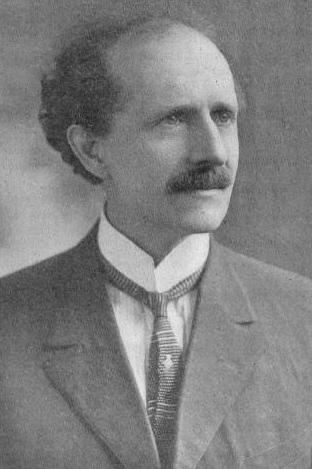
Hermann Helms
On page 50 of the February 1963 Chess Life John W. Collins wrote that
in 1950 Santasiere produced an oil painting of the position preceding 22...Qg2+,
and page 34 of the February 1963 Chess Review reported that the painting
‘hangs in the Marshall Chess Club’. Santasiere’s obituary
on page 160 of the March 1977 Chess Life & Review related that ‘he
had painted over 400 canvases’, but what details can be found about a
painting depicting the Helms game?
A photograph from page 110 of the April 1943 Chess Review:
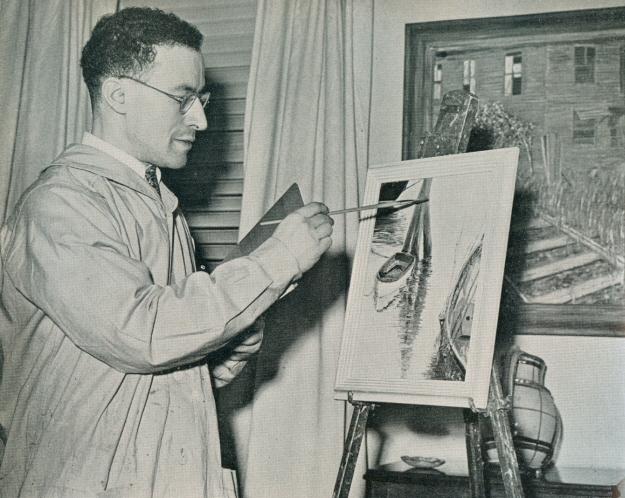
Anthony Edward Santasiere
As regards the 23-move brilliancy, the evidence currently available suggests
the following:
James Ferguson Smyth v Hermann Helms
Practice game, Manhattan Chess Club, New York, 28 May 1915.
Submit information
or suggestions on chess explorations
All ChessBase articles
by Edward Winter
 Edward
Winter is the editor of Chess
Notes, which was founded in January 1982 as "a forum for aficionados
to discuss all matters relating to the Royal Pastime". Since then, over 6,930
items have been published, and the series has resulted in four books by Winter:
Chess
Explorations (1996), Kings,
Commoners and Knaves (1999), A
Chess Omnibus (2003) and Chess
Facts and Fables (2006). He is also the author of a monograph
on Capablanca (1989).
Edward
Winter is the editor of Chess
Notes, which was founded in January 1982 as "a forum for aficionados
to discuss all matters relating to the Royal Pastime". Since then, over 6,930
items have been published, and the series has resulted in four books by Winter:
Chess
Explorations (1996), Kings,
Commoners and Knaves (1999), A
Chess Omnibus (2003) and Chess
Facts and Fables (2006). He is also the author of a monograph
on Capablanca (1989).
Chess Notes is well known for its historical research, and anyone browsing
in its archives
will find a wealth of unknown games, accounts of historical mysteries, quotes
and quips, and other material of every kind imaginable. Correspondents from
around the world contribute items, and they include not only "ordinary readers"
but also some eminent historians – and, indeed, some eminent masters. Chess
Notes is located at the Chess
History Center. Signed copies of Edward Winter's publications are
currently available.
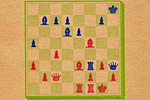


















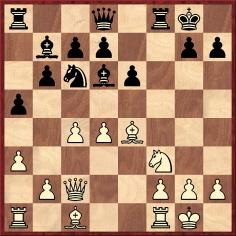


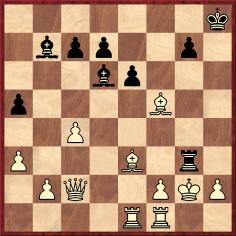



 Edward
Winter is the editor of
Edward
Winter is the editor of 